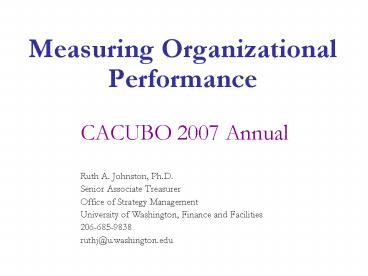Measuring Organizational Performance - PowerPoint PPT Presentation
1 / 30
Title:
Measuring Organizational Performance
Description:
Campuses in Seattle, Tacoma and Bothell. 17 major schools & colleges. UW Medicine: (School of Medicine, University of Washington Medical Center, ... – PowerPoint PPT presentation
Number of Views:54
Avg rating:3.0/5.0
Title: Measuring Organizational Performance
1
Measuring Organizational Performance
- CACUBO 2007 Annual
- Ruth A. Johnston, Ph.D.
- Senior Associate Treasurer
- Office of Strategy Management
- University of Washington, Finance and Facilities
- 206-685-9838
- ruthj_at_u.washington.edu
2
The University of Washington
- Founded November 1861
- 42,000 Students (undergraduate, graduate,
professional) - 990M Research Awards (largest federally funded
public research institution in America) - Campuses in Seattle, Tacoma and Bothell
- 17 major schools colleges
- UW Medicine (School of Medicine, University of
Washington Medical Center, Harborview Medical
Center, and UW Physicians Neighborhood Clinics) - 1.7B Endowment
3
University of Washington Finance and Facilities
includes
- Financial Management Financial Accounting,
Financial Services, Payroll, Purchase Goods and
Services, Research Accounting and Analysis, Risk
Management, Student Fiscal Services - Treasury and Investments
- Facilities Services
- Capital Projects Office
- Office of Strategy Management
4
(No Transcript)
5
Real Estate Office Strategy Map
6
Why Measure?
Why Measure?
- Respond to requests for information
- Need to show effectiveness in order to
- Keep or get more resources
- Influence decision makers
- Manage by facts
- Help your staff, leaders and boss understand your
business - Work better with process partners
- Share information with others (helps
- lead to discovery of new solutions)
- Try new things
7
Ways We Get Information on Our Effectiveness
- Anecdotal (parents, students, staff, etc.)
- Letters, emails, calls
- Surveys
- Intuition
- Measurement
- Data Warehouses
- Benchmarking with others
- (constantly researching options helps identify
methods that havent been thought of)
8
Dashboard
- What do the gauges tell us?
9
Evaluating and Measuring Effectiveness
- How do you know you are doing a good job?
- How do you know you are doing the right job?
- Takes a balance of measures
- Customer
- Financial
- Internal Work Processes
- Learning Growth
10
What is the Balanced Scorecard?
- Robert Norton and David Kaplan (first published
in 1992) - Theory
- Key Definitions (strategy, initiative, goal,
measure) - Difference between operational and strategic
measures
11
Balanced Scorecard Strategy
- Strategy is an organizations plan to look
forward - Initiatives are the key action programs needed to
achieve the strategy - Illustrates patterns to examine past performance
- Measures are chosen to track success
- Targets are the level of performance needed
12
Structure of the Scorecard
- Financial
- Financial performance
- Customer
- Identification of the customer segments and what
they value - Internal Process
- Work flow towards accomplishment of strategies
- Learning and Growth
- The employees, organizational structure,
capacity, and training and development
13
Measuring Performance
- What are your key processes?
- What do you do now to measure effectiveness?
- Where do you get the data?
- Do you have targets? How were they determined?
- What should you measure that you arent?
- How are you using your measures
- First think about these questions and then you
will discuss with others around you.
14
Metrics Template
- What information should be on your metrics pages?
15
(No Transcript)
16
Financial Management Dashboard
- FM http//www.washington.edu/admin/finmgmt/
17
Financial Management Dashboard
18
Financial Management Dashboard
19
Financial Management Dashboard
20
(No Transcript)
21
(No Transcript)
22
(No Transcript)
23
(No Transcript)
24
(No Transcript)
25
(No Transcript)
26
Who Manages the Scorecard?
- Make it someones job
- Job components
- Align initiatives with strategy
- Work with staff developing measures
- Coordinate and present the data
- Update the process
- Periodically challenge and revise the measures
- Communicate
27
How the Dashboard is Used
- To educate staff and leaders about current
effectiveness - To identify where process improvements should
take place - To build credibility
- To allocate resources
- To align operational with strategic work
- To provide incentives and rewards
28
Learnings
- Leaders struggle when measures dont look good
- An iterative process its continual
- Should be a staff tool but managers use it more
- We need to build the staff capacity to do this
work - Requires honest and sometimes scary discussions
- Changes the culture
- Must talk about it and explain it well
- Must value feedback from staff and customers
- Must use it to identify and measure needed
changes
29
Importance/Value of This Work
- Its hard work but worth it
- Needs your commitment and leadership
- Builds your and your offices credibility
- Must review frequently (after each term)
- You improve what you measure
- Helps gain support
- Review and understand trend lines and plan
accordingly - Helps with focus
- Dynamic and ever-changing
30
Selected Readings/Resources
By Robert Kaplan and David Norton
- The Balanced Scorecard Measures That Drive
Performance. Harvard Business Review (HBR) 70,
no. 1 (JanuaryFebruary 1992) 7179 - Putting The Balanced Scorecard To Work. HBR 71,
no. 5 (SeptemberOctober 1993) 134147. - The Balanced Scorecardtranslating Strategy Into
Action. Boston Harvard Business School, 1996. - Using The Balanced Scorecard As A Strategic
Management System. HBR 74, no.1 (JanuaryFebruary
1996) 75. - Balanced Scorecard Collaborative (training,
consulting, materials) http//www.bscol.com/































